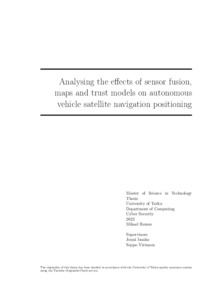Analysing the effects of sensor fusion, maps and trust models on autonomous vehicle satellite navigation positioning
Remes, Mikael (2022-06-21)
Analysing the effects of sensor fusion, maps and trust models on autonomous vehicle satellite navigation positioning
Remes, Mikael
(21.06.2022)
Julkaisu on tekijänoikeussäännösten alainen. Teosta voi lukea ja tulostaa henkilökohtaista käyttöä varten. Käyttö kaupallisiin tarkoituksiin on kielletty.
avoin
Julkaisun pysyvä osoite on:
https://urn.fi/URN:NBN:fi-fe2022062850325
https://urn.fi/URN:NBN:fi-fe2022062850325
Tiivistelmä
This thesis analyzes the effects of maps, sensor fusion and trust models on autonomous vehicle satellite positioning. The aim is to analyze the localization improvements that commonly used sensors, technologies and techniques provide to autonomous vehicle positioning. This thesis includes both survey of localization techniques used by other research and their localization accuracy results as well as experimentation where the effects of different technologies and techniques on lateral position accuracy are reviewed. The requirements for safe autonomous driving are strict and while the performance of the average global navigation satellite system (GNSS) receiver alone may not prove to be adequate enough for accurate positioning, it may still provide valuable position data to an autonomous vehicle. For the vehicle, this position data may provide valuable information about the absolute position on the globe, it may improve localization accuracy through sensor fusion and it may act as an independent data source for sensor trust evaluation. Through empirical experimentation, the effects of sensor fusion and trust functions with an inertial measurement unit (IMU) on GNSS lateral position accuracy are measured and analyzed. The experimentation includes the measurements from both consumer-grade devices mounted on a traditional automobile and high-end devices of a truck that is capable of autonomous driving in a monitored environment. The maps and LIDAR measurements used in the experiments are prone to errors and are taken into account in the analysis of the data.
